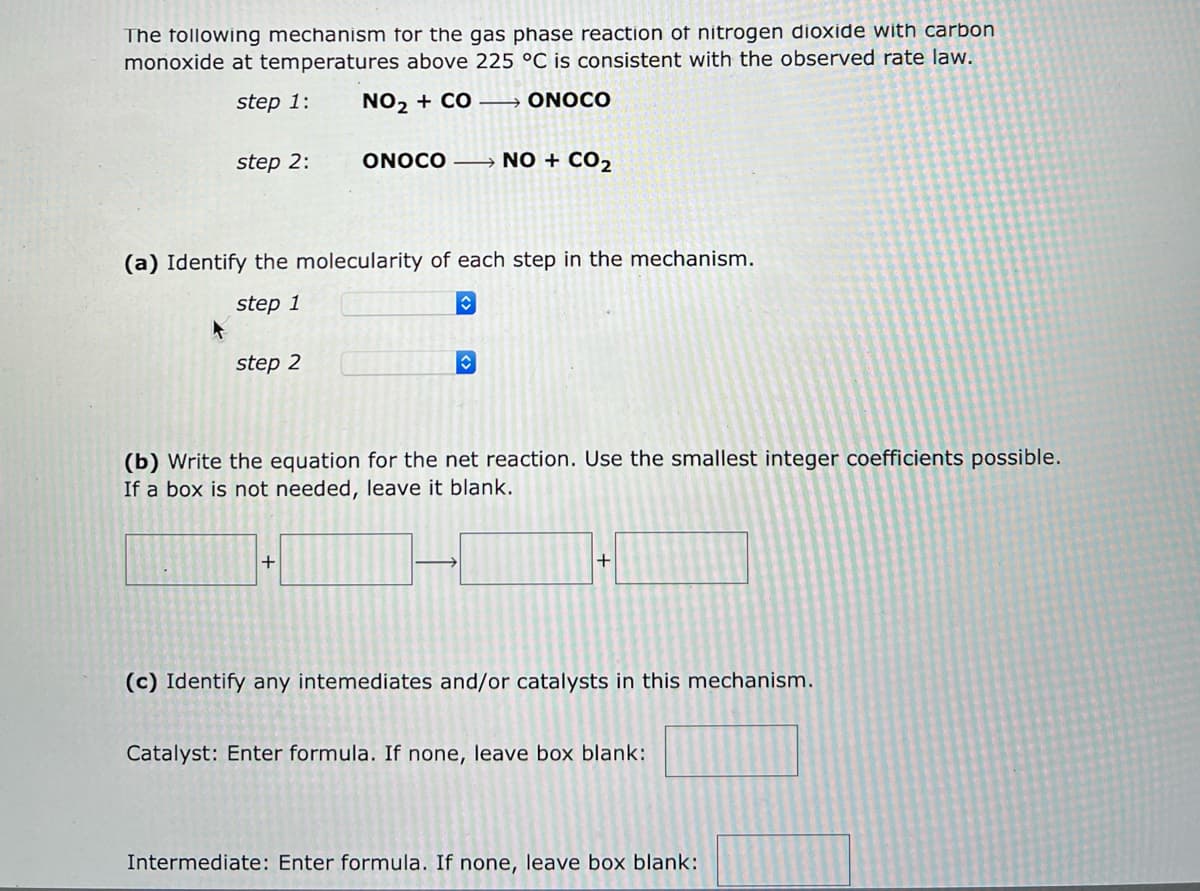The following mechanism for the gas phase reaction of nitrogen dioxide with carbon monoxide at temperatures above 225 °C is consistent with the observed rate law. step 1: NO₂ + CO→→→→→→→ ONOCO step 2: (a) Identify the molecularity of each step in the mechanism. step 1 step 2 ONOCO →→→→NO + CO₂ + ♥ ✪ (b) Write the equation for the net reaction. Use the smallest integer coefficients possible. If a box is not needed, leave it blank. + (c) Identify any intemediates and/or catalysts in this mechanism. Catalyst: Enter formula. If none, leave box blank: Intermediate: Enter formula. If none, leave box blank:
The following mechanism for the gas phase reaction of nitrogen dioxide with carbon monoxide at temperatures above 225 °C is consistent with the observed rate law. step 1: NO₂ + CO→→→→→→→ ONOCO step 2: (a) Identify the molecularity of each step in the mechanism. step 1 step 2 ONOCO →→→→NO + CO₂ + ♥ ✪ (b) Write the equation for the net reaction. Use the smallest integer coefficients possible. If a box is not needed, leave it blank. + (c) Identify any intemediates and/or catalysts in this mechanism. Catalyst: Enter formula. If none, leave box blank: Intermediate: Enter formula. If none, leave box blank:
Chemistry: Principles and Practice
3rd Edition
ISBN:9780534420123
Author:Daniel L. Reger, Scott R. Goode, David W. Ball, Edward Mercer
Publisher:Daniel L. Reger, Scott R. Goode, David W. Ball, Edward Mercer
Chapter13: Chemical Kinetics
Section: Chapter Questions
Problem 13.50QE
Related questions
Question
Help on these two plz I’m lost

Transcribed Image Text:The following mechanism for the gas phase reaction of nitrogen dioxide with carbon
monoxide at temperatures above 225 °C is consistent with the observed rate law.
step 1:
NO₂ + CO→→→→→→ONOCO
step 2:
4
(a) Identify the molecularity of each step in the mechanism.
step 1
step 2
ONOCO →→→→→NO + CO₂
+
♥
C
(b) Write the equation for the net reaction. Use the smallest integer coefficients possible.
If a box is not needed, leave it blank.
+
(c) Identify any intemediates and/or catalysts in this mechanism.
Catalyst: Enter formula. If none, leave box blank:
Intermediate: Enter formula. If none, leave box blank:

Transcribed Image Text:Identify each of the following elementary reactions as unimolecular, bimolecular, or
termolecular, and write the rate expression.
Reaction
(a) OH + HCI →→ H₂O + CI
(b) HO₂NO₂ - HO₂ + NO₂
(c)
HO + NO₂ + Ar →→ HNO3 +
Ar
Molecularity
◊
◊
◊
Rate expression
rate
rate =
rate =
Expert Solution
This question has been solved!
Explore an expertly crafted, step-by-step solution for a thorough understanding of key concepts.
Step by step
Solved in 2 steps with 1 images

Knowledge Booster
Learn more about
Need a deep-dive on the concept behind this application? Look no further. Learn more about this topic, chemistry and related others by exploring similar questions and additional content below.Recommended textbooks for you

Chemistry: Principles and Practice
Chemistry
ISBN:
9780534420123
Author:
Daniel L. Reger, Scott R. Goode, David W. Ball, Edward Mercer
Publisher:
Cengage Learning

Chemistry: The Molecular Science
Chemistry
ISBN:
9781285199047
Author:
John W. Moore, Conrad L. Stanitski
Publisher:
Cengage Learning

Chemistry: Principles and Reactions
Chemistry
ISBN:
9781305079373
Author:
William L. Masterton, Cecile N. Hurley
Publisher:
Cengage Learning

Chemistry: Principles and Practice
Chemistry
ISBN:
9780534420123
Author:
Daniel L. Reger, Scott R. Goode, David W. Ball, Edward Mercer
Publisher:
Cengage Learning

Chemistry: The Molecular Science
Chemistry
ISBN:
9781285199047
Author:
John W. Moore, Conrad L. Stanitski
Publisher:
Cengage Learning

Chemistry: Principles and Reactions
Chemistry
ISBN:
9781305079373
Author:
William L. Masterton, Cecile N. Hurley
Publisher:
Cengage Learning

Chemistry by OpenStax (2015-05-04)
Chemistry
ISBN:
9781938168390
Author:
Klaus Theopold, Richard H Langley, Paul Flowers, William R. Robinson, Mark Blaser
Publisher:
OpenStax

Chemistry for Engineering Students
Chemistry
ISBN:
9781337398909
Author:
Lawrence S. Brown, Tom Holme
Publisher:
Cengage Learning
